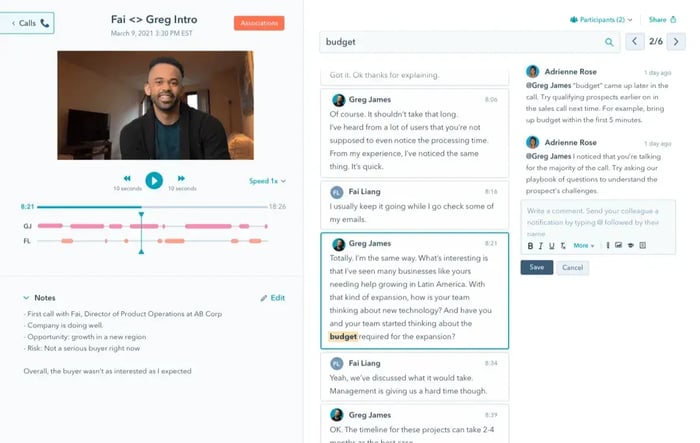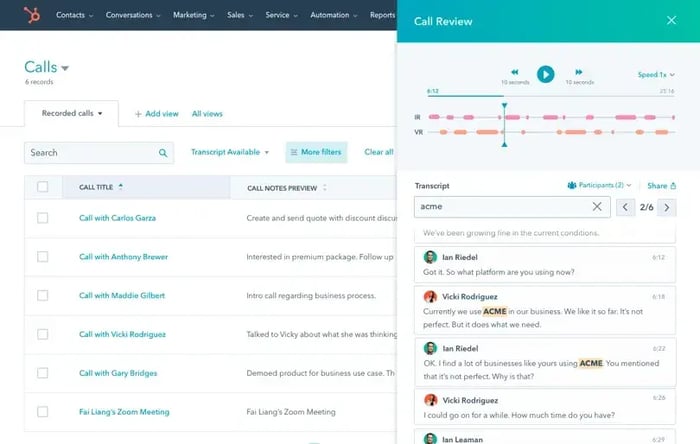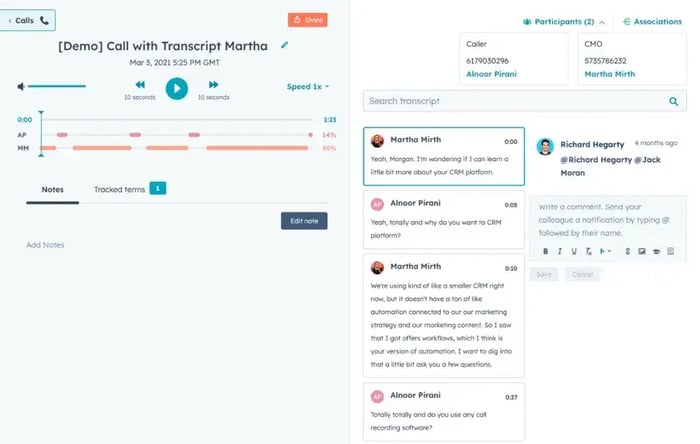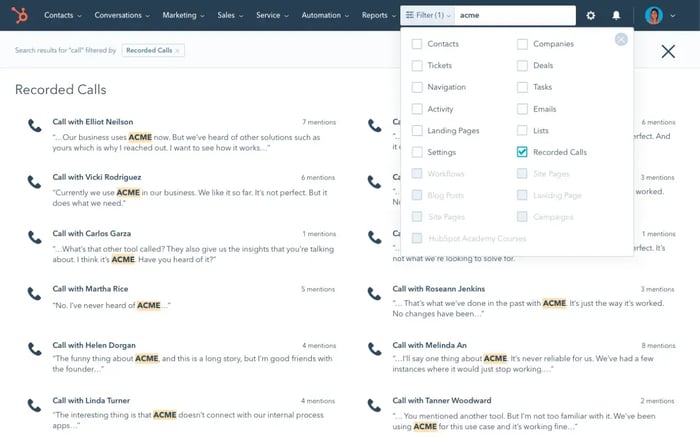SaaS sales teams are feeling a slowdown. Deals drag on for weeks, decision committees keep growing, and reps are under pressure to deliver faster results with fewer resources. In a tough landscape, AI tools like conversation intelligence (CI) can be a genuine game-changer.
Conversation intelligence uses AI to analyze customer interactions to extract actionable insights. Tools like HubSpot Conversation Intelligence provide deeper insights into calls, helping sales reps unlock opportunities and make data-driven decisions.
This post will explore what CI is, show the tangible benefits it delivers, and share how to implement HubSpot’s conversation intelligence to accelerate deal velocity.
Table of Contents
- What is AI conversation intelligence?
- The Benefits: How AI Conversation Intelligence Can Make Deal Velocity Faster
- How to Implement AI Conversation Intelligence Using HubSpot
- Reviewing Sales Conversations With vs. Without AI Analysis
- Q&A: How to Use AI Conversation Intelligence to Improve Deal Velocity
What is AI conversation intelligence?
AI conversation intelligence is software that automatically records, transcribes, and analyzes sales calls and meetings. Instead of manually reviewing call notes or relying on reps’ memories, sales leaders get structured insights into what’s happening across every deal in the pipeline.
At its core, conversation intelligence uses natural language processing (NLP) and machine learning to:
- Detects keywords, topics, and sentiment during calls.
- Identify talk-to-listen ratios, objection handling, and next steps.
- Surface patterns that lead to faster deal progression.
- Flag risks, such as a lack of decision-maker involvement or stalled follow-ups.
HubSpot’s Conversation Intelligence helps managers train new reps, identify top performers, and see performance patterns. Leaders can even leave feedback on specific moments in a call.

But even with these promises, many sales leaders ask, “What’s the average deal velocity improvement for SaaS companies using AI conversational intelligence? And is it worth adding another tool to our stack?”
To answer these questions, I asked Keiran Fallon, head of marketing at Ocuco, for his thoughts on this. Fallon told me that his sales teams added AI conversational intelligence to their processes and quickly discovered the power of smarter, more targeted conversations.
Fallon said, “On average, follow-up emails are 35% more effective because AI finds the exact pain points that prospects have mentioned.” He also added, “Higher close rates and shorter sales cycles are the outcomes of these more fruitful, consultative discussions.”
Think of conversation intelligence as a sales coach who never sleeps. Where managers used to review one or two calls per week, AI now gives teams visibility into every conversation, at scale and in real time.
Pro tip: HubSpot Conversation Intelligence provides data-driven insights from customer calls that give a complete overview of customer interactions. Sales managers can use tracked terms to identify specific conversations, report on outcomes, and automatically trigger workflows.

The Benefits: How AI Conversation Intelligence Can Make Deal Velocity Faster
AI conversation intelligence isn’t just another tool in a cluttered tech stack. AI-powered analysis delivers real, measurable impact on how deals move (or fall off) through the pipeline. Benefits include:
- Better understanding of sales qualification and more accurate forecasting.
- Coaching for reps.
- Identifying risks early.
- Accelerated onboarding.
- And stronger cross-functional alignment.
To bring this to life, I asked Fallon to share how these benefits play out. Here’s what he told me.
1. AI Call Analysis for Better Qualification
One of the biggest drags on sales velocity is poor qualification. Without proper lead qualification, reps waste cycles chasing prospects who were never a good fit or were never in the market to buy.
AI conversation analysis identifies winning behaviors, such as which discovery questions uncover budget and authority faster. In fact, top-performing SaaS sellers using AI call analysis manage 2.6 times more deals and have sales cycles that are 42% shorter than average performers.
AI sales agents also flag missed qualification steps, making it easier for sales representatives to disqualify a lead or circle back to include the appropriate decision-makers.
Fallon told me, “The secret is that AI can quickly figure out the exact words, tone, and rhythm that lead to successful sales by looking at a lot of conversations at once. By revealing these insights, the AI helps salespeople improve their outreach and tailor their messages to meet the specific needs and concerns of each prospect.”
With these insights, reps learn to zero in on high-intent buyers early, which can shorten sales cycles and create lasting connections with long-term customers.
Fallon says, “People who excel in sales are recognized for their ability to ask insightful, open-ended questions. The AI can help salespeople in real-time by determining the best order for asking questions. This ensures that they utilize these proven methods and obtain the crucial information necessary to close the deal.”
Why this matters for deal velocity: When qualification is sharper, fewer unqualified deals clog the sales pipeline. That means reps spend more time advancing opportunities that can actually close, and cycle times naturally shrink.
2. Conversation Insights for Coaching
Top sellers have 55% stronger discovery skills than their less-skilled counterparts. Although this is a wide gap, it can be narrowed with strategic coaching. The problem with coaching, however, is that it requires a time investment, and often relies on a manager’s limited bandwidth.
AI sales tools fill in the gaps, giving managers real-time insights into rep performance. This makes it easier for managers to coach reps through specific moments, such as handling objections or pricing conversations, by using concrete examples instead of vague feedback.

Pro tip: HubSpot Conversation Intelligence enables managers to become great coaches by helping them see performance patterns and leave feedback on conversations, even with limited time to shadow calls.
Fallon says this is one of the earliest and biggest benefits of adding AI to sales processes. He told me, “The AI can identify the precise wording, questioning strategies, and general approach that are associated with successful results by examining a significant number of sales calls.”
Sales is a team effort, and as Fallon said, using a CI tool helps “individual sales representatives to gradually acquire those skills, which enables organizations to scale those best practices throughout the entire sales team swiftly.”
I asked Fallon what this looks like in practice on a broader scale. He told me that his team saw a 25% decrease in the average sales cycle duration simply by adding AI insights into their current sales playbooks. Adding, “According to our experience, during the first three to four months of implementation, there is a discernible increase in sales productivity and consistency.”
Why this matters for deal velocity: Coaching no longer depends on chance or manager capacity. Instead, every rep can learn from top-performer behaviors quickly, creating a team-wide lift in win rates and faster cycle times.
3. Early Deal Risk Identification
Pipeline slippage is a roadblock that keeps deals from moving forward. When prospects are left chasing reps for updates, deals slow down and fall apart. AI conversation intelligence mitigates that risk by flagging issues before a customer feels the need to call or send an email.
Instead of waiting for prospects to raise concerns or sales reps to identify them, AI surfaces red flags that prevent deals from progressing. Some of those red flags include missing stakeholders, unanswered objections, or stalled next steps. HubSpot Conversation Intelligence helps managers understand how teams are performing on customer calls so they can identify these risks early.
These insights help managers and reps to intervene early, keeping deals on track.
A notable example is Carvana, which developed an AI-powered Conversation Analysis Review Engine (CARE) on Microsoft Azure. By proactively analyzing customer interactions, Carvana reduced inbound sales calls by 45% over a two-year period.
Reducing inbound calls might seem counterintuitive, but it’s actually a good thing. It means fewer reactive calls brought on by friction or confusion. When there’s less friction, smoother and faster customer experiences signal stronger deal momentum and a lower risk of drop-offs in the pipeline.
Why this matters for deal velocity: AI turns risk detection from reactive to proactive. By catching problems early, teams prevent pipeline stalls and keep deals moving steadily toward close.
4. Data-Driven Forecasting Accuracy
Forecasting has always been one of the toughest parts of sales leadership. Too often, reps update CRM stages based on gut feelings, which makes pipelines look healthier than they really are.
Fallon told me that one of the most surprising benefits of AI conversation intelligence was how much it improved their forecasting accuracy. At Ocuco, AI flagged that their top-performing reps always covered implementation schedules during the first call. Deals where this happened consistently closed faster and more predictably. By contrast, when implementation wasn’t discussed early, those opportunities were far more likely to stall.
The detailed level of behavioral insight helped Ocuco’s leadership team understand which deals were truly healthy and which ones were at risk, even if the CRM suggested otherwise.
Why this matters for deal velocity: When forecasts are grounded in actual buyer behaviors instead of guesswork, leaders can allocate coaching and resources more effectively. The result is a smoother pipeline and fewer deals stuck in limbo.
5. Accelerated Onboarding and Ramp Times
Ramp time has always been a challenge for sales teams. New reps often need months of shadowing and trial-and-error before they’re confident enough to run strong discovery calls. HubSpot’s Conversation Intelligence can dramatically shorten this learning curve by highlighting specific questioning sequences and behaviors that drive better outcomes.
Fallon mentioned that AI conversation intelligence dramatically shortened this learning curve for his team at Ocuco. The AI highlighted specific questioning sequences that drove better outcomes.
For example, asking about “current patient booking challenges” early in calls made optical software sales close 40% faster. Instead of waiting months to stumble across this insight, new hires could learn and apply it from their very first calls.
As Fallon put it directly: “That’s not something most new reps would figure out on their own in the first six months. It’s something we can now scale from day one.”
Why this matters for deal velocity: When new reps can adopt proven behaviors immediately, ramp times shrink, deals close sooner, and growth scales without sacrificing quality.
6. Stronger Cross-Functional Alignment
Marketing, product, and customer success all play a role in how quickly deals move forward. But too often, those teams don’t have access to the voice of the customer that sales hears every day. HubSpot Conversation Intelligence gives sales and service teams a complete overview of customer interactions on one platform.
Fallon told me that one of the unexpected wins with AI conversation intelligence was how much it improved cross-functional alignment at Ocuco.
While their AI found that top reps always brought up implementation schedules and procedures during early calls, they found these insights were just useful for sales coaching. Instead, it was a clear signal for product and onboarding teams.
They began emphasizing implementation clarity earlier in the customer journey, which reduced objections and built trust sooner.
Why this matters for deal velocity: When every team works from the same buyer insights, prospects hear a consistent story, objections are addressed proactively, and the transition from sales to delivery feels seamless. That consistency keeps deals moving quickly instead of slowing them down with uncertainty.
How to Implement AI Conversation Intelligence Using HubSpot
Adding AI CI to your sales tech stack is a smart way to stay ahead of the competition, close more deals, and move closer to your overall goals.
Here’s how to use HubSpot’s AI Conversation Intelligence to support your sales teams.

1. Integrate HubSpot Conversation Intelligence with CRM and call platforms.
Before generating insights, teams must have the foundation to record conversations reliably and feed them into a CRM. The value of AI conversation intelligence starts with clean, connected data flowing from every customer interaction.
Here’s how to connect data to HubSpot.
Step 1: Connect call recordings to HubSpot Conversation Intelligence.
- Connect sources: Zoom, Zoom Phone, HubSpot Calling, Dialpad, Aircall, or Gong to auto-record and push transcripts into Contact/Company/Deal timelines.
- Turn on auto-log: Enable “Log and transcribe calls” so AI summaries, action items, and snippets attach to the right records.
- Standardize IDs: Map external call IDs to a custom property to avoid duplicates and preserve lineage.
- Security and consent: Enable call recording notices and document consent in a Call Consent property.
Step 2: Configure analysis triggers and data sync.
- Scope analysis: Create call types, like Discovery, Demo, Pricing/Negotiation, or Exec Review, via a dropdown property. Then, trigger CI analysis only for scoped types.
- Map to deals: Use a workflow, such as “If a call includes a tracked Contact linked to ≥1 Open Deal, attach insights to the Primary Open Deal by stage priority.”
- Write back key fields: Persist AI outputs into properties on the Deal record so they’re reportable and trigger automation.
2. Define winning behaviors & metrics.
AI is only as powerful as the rules and benchmarks you set. To accelerate lead velocity, sales reps will need to define what “good” looks like in a conversation and then measure calls against those standards.
Follow these steps.
Step 1: Map ideal call attributes.
Create a scoring rubric, or a playbook, for each call type. Here’s an example discovery rubric, totaling up to 100 pts:
- Problem clarity established (20)
- Impact quantified (15)
- Stakeholders identified (15)
- Budget/timing explored (20)
- Next step secured with date (20)
- Mutual action plan referenced (10)
Save this rubric in HubSpot Playbooks so managers and reps can apply it live and CI can mirror the criteria for AI scoring.
Step 2: Set up score thresholds.
Translate rubrics into thresholds that drive automation. Here’s a quick overview of some thresholds you might set:
- CI Qualification Score ≥ 75: Fast-Track lane
- CI Stakeholder Coverage ≥ 2 by Stage 2: Healthy; else add Risk Flag
- CI Next Step Confidence = Low: create a task for rep within 4 hours and notify coach
- CI Objection Risk = High: enroll deal in “Objection Handling” coaching workflow
3. Build coaching and alert workflows in HubSpot Conversation Intelligence.
Insights matter most when they drive action. The real power of conversation intelligence lies in how coaching and risk alerts flow seamlessly to managers and reps in real-time, ensuring no deal is left behind.
Follow these setups to set up your coaching and alert workflows.
Step 1: Create real-time alert workflows for sales coaches.
- Trigger: CI Risk Flags contains any OR CI Next Step Confidence = Low OR No next meeting within 7 days.
- Actions:
- Slack/Teams DM to owner + coach with deal info and call snippet link.
- Create a Coach Review Task due in 24 hours.
- Add a call to a “Coachable Moments” Playlist.
Step 2: Automate feedback loops to reps.
- Snippet delivery: Email the AI summary and 30- to 60-second call clips to the representative.
- Playbook suggestion: Auto-attach the relevant Playbook.
- Micro-nudges: If the Talk/Listen ratio is greater than 70/30 twice in a week, send a nudge with a discovery question set.
4. Monitor performance and iterate.
The final step is about discipline. HubSpot Conversation Intelligence provides sales reps with dashboards and signals, but velocity improves only if teams consistently review the data, act on it, and refine models over time.
Think of this as a weekly performance tune-up.
Step 1: Review velocity and win-rate dashboards weekly.
Create a Deal Velocity Dashboard with metrics like:
- Avg Sales Cycle (days)
- Stage Age and Stalled Deal Count
- Win Rate % by CI score bands
- % Deals with Decision-Maker by Stage 2
- Next Step Coverage (%)
- Risk Flag Incidence trends
Step 2: Refine behavior models based on outcomes.
- Closed-won back-testing: Compare won vs. lost to adjust weights.
- A/B test behaviors: Track the impact of new scripts or messaging.
- Refresh playbooks quarterly: Add new top-performer patterns.
- Governance: Review consent, model drift, and updates monthly.
By connecting calls, defining behaviors, automating coaching, and tracking performance, HubSpot Conversation Intelligence creates a closed-loop system that continuously improves deal velocity.
Reviewing Sales Conversations With vs. Without AI Analysis
Task | Time with AI | Time without AI |
Reviewing a sales call | 5 minutes (summary and highlights) | 45 to 60 minutes (manual listen) |
Identifying qualification gaps | Automatic, real-time | Post-hoc, often missed |
Coaching reps on objection handling | Real-time snippets | Weekly or monthly 1:1s |
Flagging at-risk deals | Instant alerts | Weeks late, if at all |
Cycle time analysis | Automatic dashboards | Manual spreadsheet analysis |
Q&A: How to Use AI Conversation Intelligence to Improve Deal Velocity
Which conversations matter most?
Discovery and late-stage negotiation calls are the biggest levers. Discovery shows if reps qualify effectively and secure next steps, while late-stage calls reveal how they handle pricing, objections, and competitors. Analyzing these with AI pinpoints exactly where deals speed up or stall.
How quickly do we see improvement?
Most SaaS teams see results in 30 to 60 days. Early wins come from flagging obvious risks, such as missing decision-makers, while longer-term gains emerge as representatives consistently replicate winning behaviors. HubSpot Conversation Intelligence dashboards make ROI visible almost immediately.
What’s the impact of sales methodology?
AI conversation intelligence is methodology-agnostic. Whether sales teams use MEDDIC, Challenger, or SPIN, it translates abstract steps into measurable behaviors — like quantifying pain, reframing thinking, or securing commitments — so the chosen framework is reinforced in every call.
How to integrate with the existing tech stack?
HubSpot Conversation Intelligence integrates with Zoom, Google Meet, Salesforce, and sales engagement tools like Outreach. Insights flow into the CRM your team already uses, reducing friction and keeping everything in one place.
How to ensure privacy and compliance?
Always disclose recordings and follow regional consent rules. HubSpot Conversation Intelligence supports GDPR and SOC 2 compliance, as well as retention policies, role-based access, and anonymization, allowing sales teams to move faster without creating legal headaches.
Why Deal Velocity Can’t Wait
The SaaS teams that treat AI conversation intelligence as a growth lever are the teams winning in today’s market. They close deals faster, coach smarter, and catch risks before they sink revenue. HubSpot Conversation Intelligence gives you that edge without adding complexity.
If you’ve been watching deals drag on or wondering how to get more out of the team you already have, this is the moment to act. By connecting your calls, defining winning behaviors, automating coaching, and monitoring performance, you build a closed-loop system that compounds over time. Faster cycles, higher win rates, and predictable growth become the norm, not the exception.
Your Deal Velocity Takeaways
- Integrate conversation intelligence with HubSpot so every conversation is captured and analyzed.
- Define winning behaviors and scoring thresholds to create a clear standard for what “good” looks like.
- Automate coaching workflows and risk alerts so managers intervene at the right time and reps self-correct quickly.
- Track dashboards weekly and refine models to make each cycle shorter and stronger than the last.
Don’t let another quarter slip by with deals stuck in limbo. Deploy HubSpot Conversation Intelligence and accelerate your path to revenue today.
![]()



Leave a Reply